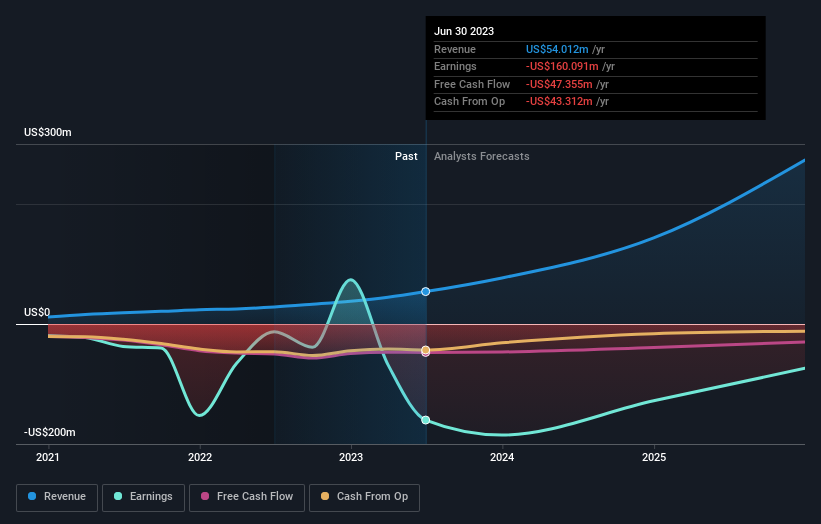- United States
- /
- Semiconductors
- /
- NasdaqGM:NVTS
Institutions along with individual investors who hold considerable shares inNavitas Semiconductor Corporation (NASDAQ:NVTS) come under pressure; lose 8.2% of holdings value

Key Insights
- Navitas Semiconductor's significant individual investors ownership suggests that the key decisions are influenced by shareholders from the larger public
- A total of 13 investors have a majority stake in the company with 51% ownership
- Recent sales by insiders
A look at the shareholders of Navitas Semiconductor Corporation (NASDAQ:NVTS) can tell us which group is most powerful. We can see that individual investors own the lion's share in the company with 34% ownership. That is, the group stands to benefit the most if the stock rises (or lose the most if there is a downturn).
While the holdings of individual investors took a hit after last week’s 8.2% price drop, institutions with their 33% holdings also suffered.
In the chart below, we zoom in on the different ownership groups of Navitas Semiconductor.
View our latest analysis for Navitas Semiconductor

What Does The Institutional Ownership Tell Us About Navitas Semiconductor?
Institutional investors commonly compare their own returns to the returns of a commonly followed index. So they generally do consider buying larger companies that are included in the relevant benchmark index.
We can see that Navitas Semiconductor does have institutional investors; and they hold a good portion of the company's stock. This implies the analysts working for those institutions have looked at the stock and they like it. But just like anyone else, they could be wrong. When multiple institutions own a stock, there's always a risk that they are in a 'crowded trade'. When such a trade goes wrong, multiple parties may compete to sell stock fast. This risk is higher in a company without a history of growth. You can see Navitas Semiconductor's historic earnings and revenue below, but keep in mind there's always more to the story.

Navitas Semiconductor is not owned by hedge funds. Because actions speak louder than words, we consider it a good sign when insiders own a significant stake in a company. In Navitas Semiconductor's case, its Senior Key Executive, Ranbir Singh, is the largest shareholder, holding 14% of shares outstanding. In comparison, the second and third largest shareholders hold about 5.5% and 5.1% of the stock. Furthermore, CEO Eugene Sheridan is the owner of 2.8% of the company's shares.
A closer look at our ownership figures suggests that the top 13 shareholders have a combined ownership of 51% implying that no single shareholder has a majority.
While studying institutional ownership for a company can add value to your research, it is also a good practice to research analyst recommendations to get a deeper understand of a stock's expected performance. Quite a few analysts cover the stock, so you could look into forecast growth quite easily.
Insider Ownership Of Navitas Semiconductor
The definition of company insiders can be subjective and does vary between jurisdictions. Our data reflects individual insiders, capturing board members at the very least. The company management answer to the board and the latter should represent the interests of shareholders. Notably, sometimes top-level managers are on the board themselves.
Insider ownership is positive when it signals leadership are thinking like the true owners of the company. However, high insider ownership can also give immense power to a small group within the company. This can be negative in some circumstances.
Our information suggests that insiders maintain a significant holding in Navitas Semiconductor Corporation. Insiders own US$198m worth of shares in the US$997m company. We would say this shows alignment with shareholders, but it is worth noting that the company is still quite small; some insiders may have founded the business. You can click here to see if those insiders have been buying or selling.
General Public Ownership
With a 34% ownership, the general public, mostly comprising of individual investors, have some degree of sway over Navitas Semiconductor. While this size of ownership may not be enough to sway a policy decision in their favour, they can still make a collective impact on company policies.
Private Equity Ownership
With a stake of 11%, private equity firms could influence the Navitas Semiconductor board. Some investors might be encouraged by this, since private equity are sometimes able to encourage strategies that help the market see the value in the company. Alternatively, those holders might be exiting the investment after taking it public.
Next Steps:
I find it very interesting to look at who exactly owns a company. But to truly gain insight, we need to consider other information, too. Be aware that Navitas Semiconductor is showing 3 warning signs in our investment analysis , you should know about...
But ultimately it is the future, not the past, that will determine how well the owners of this business will do. Therefore we think it advisable to take a look at this free report showing whether analysts are predicting a brighter future.
NB: Figures in this article are calculated using data from the last twelve months, which refer to the 12-month period ending on the last date of the month the financial statement is dated. This may not be consistent with full year annual report figures.
Valuation is complex, but we're here to simplify it.
Discover if Navitas Semiconductor might be undervalued or overvalued with our detailed analysis, featuring fair value estimates, potential risks, dividends, insider trades, and its financial condition.
Access Free AnalysisHave feedback on this article? Concerned about the content? Get in touch with us directly. Alternatively, email editorial-team (at) simplywallst.com.
This article by Simply Wall St is general in nature. We provide commentary based on historical data and analyst forecasts only using an unbiased methodology and our articles are not intended to be financial advice. It does not constitute a recommendation to buy or sell any stock, and does not take account of your objectives, or your financial situation. We aim to bring you long-term focused analysis driven by fundamental data. Note that our analysis may not factor in the latest price-sensitive company announcements or qualitative material. Simply Wall St has no position in any stocks mentioned.
About NasdaqGM:NVTS
Navitas Semiconductor
Designs, develops, and markets gallium nitride power integrated circuits, silicon carbide, associated high-speed silicon system controllers, and digital isolators used in power conversion and charging.
Flawless balance sheet moderate.


